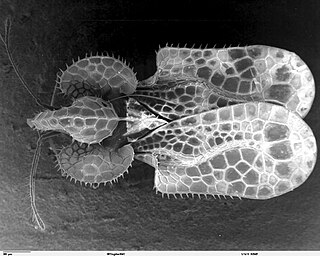
The Cimicomorpha are an infraorder of insects in the order Hemiptera, the true bugs. The rostrum and other morphology of all members apparently is adapted to feeding on animals as their prey or hosts. Members include bed bugs, bat bugs, assassin bugs, and pirate bugs.

Baetidae is a family of mayflies with about 1000 described species in 110 genera distributed worldwide. These are among the smallest of mayflies, adults rarely exceeding 10 mm in length excluding the two long slender tails and sometimes much smaller, and members of the family are often referred to as small mayflies or small minnow mayflies. Most species have long oval forewings with very few cross veins but the hindwings are usually very small or even absent. The males often have very large eyes, shaped like turrets above the head.
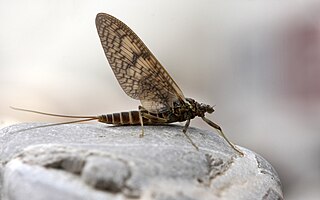
The Heptageniidae are a family of mayflies with over 500 described species mainly distributed in the Holarctic, Oriental, and Afrotropical regions, and also present in the Central American Tropics and extreme northern South America.

Leptophlebiidae is a family belonging to the Ephemeropterans that are commonly known as the prong-gilled mayflies or leptophlebiids. It is the only family in the superfamily Leptophlebioidea. There are more than 650 described species of Leptophlebiids, which are easily recognized by the forked gills present on the larvae's abdomen, thus their common name.
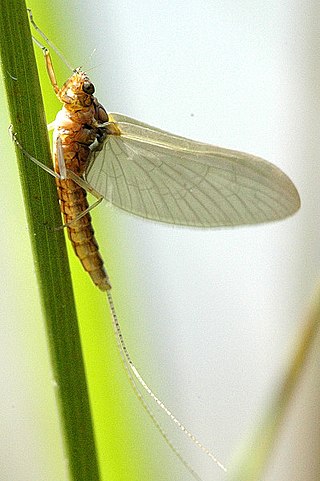
Caenis is a genus of mayflies. They are very small in size, sometimes with a body of only an 1/8 of an inch (3.2 mm).

Cloeon is a cosmopolitan genus of mayflies of the family Baetidae.

Labiobaetis is a genus of mayflies in the family Baetidae.

Habrophlebia is a genus of prong-gilled mayflies in the family Leptophlebiidae. Species of Habrophlebia have been recorded from the Palaearctic and Nearctic realms.
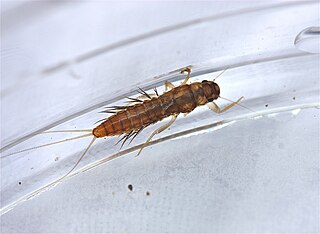
Paraleptophlebia is a genus of mayflies in the family Leptophlebiidae. Commonly found in North America and parts of Western Europe including the British Isles.
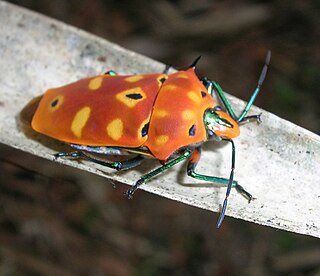
Cantao is a genus of true bugs in family Scutelleridae and tribe Scutellerini.

Raphidia is a genus of snakefly, mainly found in Europe.

Delphacinae is a subfamily of delphacid planthoppers in the family Delphacidae. There are at least 1,700 described species in Delphacinae.
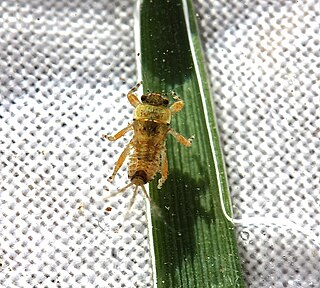
Ephemerella is a genus of spiny crawler mayflies in the family Ephemerellidae with a widespread distribution.

Teloganopsis is a genus of spiny crawler mayflies in the family Ephemerellidae. There are about 17 described species in Teloganopsis.

Pseudocloeon is a genus of mayflies belonging to the family Baetidae.

Inocellia is the Palaearctic type genus of the family Inocelliidae: belonging to the snakeflies and their allies. Distribution records are from mainland Europe and Asia: especially in the more temperate zones.
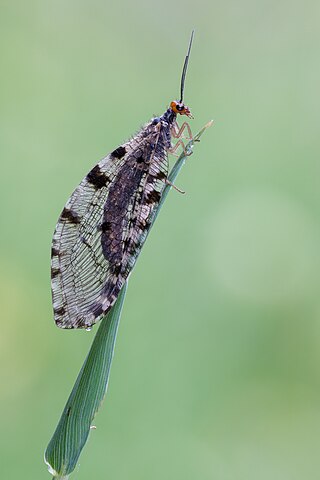
Osmylus is a genus of large lacewings, typical of the family Osmylidae, first described by Pierre André Latreille in 1802. Species are recorded mostly from Europe and Asia.
Alainites is a genus of Palaearctic and Oriental mayflies in the family Baetidae, erected by R.D. Waltz et al. in 1994. About eight species are predominantly European, with A. muticus(Linnaeus, 1758) previously considered a species group of the genus Baetis. The latter is sometimes called the "iron blue", although this name is used by anglers to include at least two species in the related genus Nigrobaetis and has a widespread distribution, including the British Isles.
















